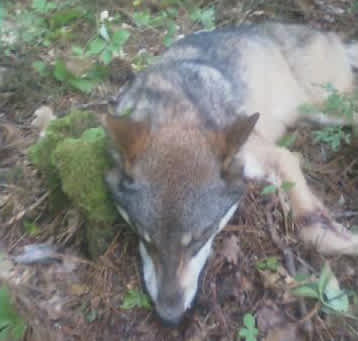Tests Confirm Trapped Wolf’s Involvement in Attack on Minnesota Teen
OutdoorHub Reporters 09.30.13

Officials with the Minnesota Department of Natural Resources have announced that DNA tests have confirmed a gray wolf trapped and killed on August 26 was the same one that attacked a teen at a local campground two days earlier.
“We were confident that the wolf involved in the attack was removed based on the description and location of the wolf captured following the incident,” Michelle Carstensen, a program supervisor with the DNR, said in a statement. “DNA results provide further assurance that the wolf we captured was the animal involved.”
The incident was the first reported wolf attack on a human in Minnesota history. The victim, 16-year-old Noah Graham, is now recovering after sustaining non-life-threatening injuries to the back of his head. Graham was camping at the West Winnie Campground near Lake Winnibigoshush with friends from church when the incident occurred. The group had bedded down and was preparing to sleep early in the morning of August 24 when the wolf approached. The animal was a young 75-pound male that the DNR estimated to be less than two years old. Male gray wolves usually reach sexual maturity at two years of age.
The wolf surprised Graham from behind and began biting the teen’s head, leaving various puncture wounds and lacerations. Graham was able to wrestle the wolf off and eventually drive it away with shouts and kicks. DNR biologists say it is very rare for wolves to approach humans or scavenge near areas with a lot of people. Officials explain that this particular wolf may have been an exception due to crippling deformities that forced it to rely on scraps found on the campground.
A necropsy revealed severe facial and dental deformities as well as signs of brain damage potentially due to infection. The veterinarian who performed the necropsy, Anibal G. Armien, said it was possible that the wolf suffered a severe injury when it was younger.
“We can’t know with certainty why this wolf approached and bit the teen,” Carstensen said. “But the necropsy results support the possibility that its facial deformity, dental abnormalities and brain damage predisposed it to be less wary of people and human activities than what is normally observed in healthy wild wolves and also affected its ability to effectively capture wild prey.”
The wolf did not have rabies. The U.S Forest Service has since reopened the campground to visitors.
Experts with the Minnesota DNR also provide the following tips when dealing with wolves.
Don’t make homes or camps attractive to wild animals:
- Keep a clean camp; don’t dispose of food by dumping into the campfire.
- Don’t leave unwashed cooking utensils around your camp.
- Don’t leave garbage unsecured.
- Don’t cook food near your tent or sleeping area.
- Don’t allow pets to freely roam away from your home or camp.
- Don’t leave pet food or other food attractants out near your home or camp.
- Don’t bury garbage, pack it out.
In the rare event that you do have an encounter with an aggressive wolf:
- Don’t run, but act aggressively, stepping toward the wolf and yelling or clapping your hands if it tries to approach.
- Do not turn your back toward an aggressive wolf, but continue to stare directly at it. If you are with a companion and more than one wolf is present place yourselves back to back and slowly move away from the wolves.
- Retreat slowly while facing the wolf and act aggressively.
- Stand your ground if a wolf attacks and fight with any means possible (use sticks, rocks, ski poles, fishing rods or whatever you can find).
- Use air horns or other noise makers.
- Use bear spray or firearms if necessary.

